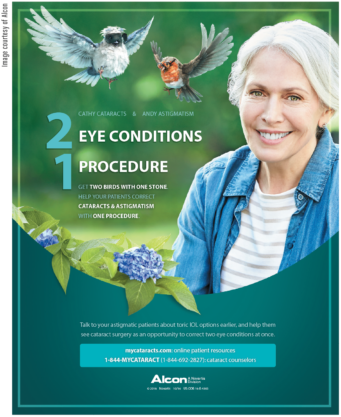You just diagnosed cataracts in the patient in your chair, and while you launch into your thorough, well-practiced explanation, your patient is likely fixated on the word cataract and not fully listening. What happens next? In many cases, the patient goes online at the first opportunity, enters the search term “cataract,” and is rewarded with literally 15 million results from sources far and wide, accurate and not so much. By the time the patient sees the surgeon for an evaluation, confusion reigns, and the education process starts anew as the patient needs help differentiating fact from fiction. Whether you are the referring doctor or the surgeon, you likely recognize this scenario. Now, help is just a click away.
Education That Resonates
Educating patients is an integral part of cataract care. With an estimated 38.7 million people expected to be affected by 2030,1 efficient dissemination of accurate, timely information is increasingly important. While ophthalmologists and optometrists are well-equipped to handle this task, they are increasingly finding that “Dr. Google” has preempted their education efforts.
About a year ago, Alcon tapped the analytics gurus at Google to learn about the online behaviors of consumers, specifically potential cataract patients. They learned that the Internet is an everyday part of boomers’ and seniors’ lives, outpacing TV and print media as the top source for gathering information.2 In 2016 alone, Google reported 15.75 million cataract-related queries, representing 14% growth year over year. In addition, more than half of boomers and seniors watch online videos—82% of these viewers prefer YouTube—and three out of four of them take action as a result of watching videos.2
Armed with a wealth of data from Google and other sources, Alcon marshaled its own extensive educational resources and set out to build an engaging, instructive website to provide patients with up-to-date, accurate information in a format they are known to prefer.
The result is mycataracts.com (Figure), an attractive, user-friendly compendium of all things cataract, from basic definitions to causes and treatment options. Visitors to the site can click through numerous well-defined menus to view simple yet informative animations and YouTube videos, including clips of real patients, talking about their own experiences and the benefits they derived from cataract surgery.
While mycataracts.com is directed toward consumers, referring doctors and surgeons appreciate its value as an adjunct to the education they provide in their practices.
Basic Facts to Build Upon
According to market research, 86% of patients conduct a health-related search before scheduling a doctor’s appointment.3 When they use trusted sources, the advantage is apparent when the patient visits the physician’s office. Patient encounters are more meaningful and efficient when patients arrive well informed.
“The biggest hurdle we face as surgeons is educating patients on what a cataract is and what their options are for treatment,” says Lawrence Woodard, MD, medical director of Omni Eye Services of Atlanta. “Mycataracts.com does a great job of providing this basic information, including options to correct astigmatism and presbyopia, before patients arrive at my office.
“When I can spend less time educating and more time learning what patients want from their cataract surgery, they have a better overall experience and are better able to make informed decisions about their options,” he says. “The overall result is better outcomes.”
Elizabeth Yeu, MD, a partner at Virginia Eye Consultants in Norfolk, Va., agrees. “A patient-centric experience enhances satisfaction,” she says. “It starts with education and discussions about the patients’ best options for uncorrected quality of vision and what they can expect after cataract surgery.”
Sharing Care Efficiently
Both surgeons rely on doctors in their referral networks to begin the education process.
“We have seen a paradigm shift in the way eye care is trending, and I believe it will continue to change as we witness greater collaboration and sharing of patients MD to MD and OD to MD,” Dr. Yeu says. She notes the number of people who are in the age-appropriate population for cataract surgery is increasing, and they will need both medical and surgical care, while the number of ophthalmologists being graduated is decreasing. This trend could potentially hamper access to eye care, save for the fact that more optometrists are getting subspecialty or fellowship training in primary care diseases. “Seventy-four percent of my referring doctors are from our OD network, and I think eye care will continue to move in that direction because of the growing need,” Dr. Yeu says.
Andrew S. Morgenstern, OD, who practices at the Vision Center of Excellence at Walter Reed National Military Medical Center in Bethesda, Md., is on the leading edge of this trend.
“One of our biggest challenges is managing patients’ expectations for cataract surgery,” he says. “The more information they can learn ahead of time, the better their experience will be.
“When I direct patients to mycataracts.com, I am confident they will be viewing accurate, objective information,” Dr. Morgenstern says. He notes the website does not promote any of the manufacturer’s products, but when he sees the Alcon logo on every page, he is reassured that all of the content has been thoroughly reviewed. “The site presents numerous treatment options that patients wouldn’t otherwise know about on their own.”
According to Dr. Morgenstern, a key benefit of having mycataracts.com as an educational resource is that every patient who views it sees the same information presented in the same manner. “I cannot guarantee that I will repeat the same information, word for word, to every patient 100% of the time,” he says. “Whereas, if my patient tells me he or she reviewed the entire website, I know exactly what was presented. This is a thorough and efficient way to deliver this information.”
According to Dr. Woodard, “Patients are much more comfortable during their visit when they know what to expect before they arrive in my office. That also makes my discussion about their various options so much better. Not only do they know what a cataract is, but they also know we have lenses that will correct astigmatism and presbyopia.”
Dr. Yeu urges everyone in her OD network to have their patients visit her practice’s website and also mycataracts.com before their evaluation at her office so they have some background information before they see her. “When they arrive, they have a basic understanding of the process, and knowing what to expect can allay their anxiety and provide some level of security,” she says.
Conclusion
Each of these doctors has well-established processes for educating patients about cataract surgery. They incorporate resources that support their overall philosophy, such as the practice’s website, pamphlets and brochures, and the services of a patient counselor. They agree that mycataracts.com complements their educational efforts, presenting trusted information in a unique format that resonates with patients.
As Dr. Morgenstern notes: “Mycataracts.com is an excellent tool and a necessary component of the patient education process. It is a great resource that is part of the whole continuum of comanaged cataract surgery care.”
1. National Eye Institute. Eye Disease Statistics. https://nei.nih.gov/sites/default/files/nei-pdfs/NEI_Eye_Disease_Statistics_Factsheet_2014_V10.pdf. Accessed April 12, 2017.
2. Google. Reaching Today’s Boomers & Seniors Online. https://ssl.gstatic.com/think/docs/reaching-todays-boomers-and-seniors-online_research-studies.pdf. Accessed April 12, 2017.
3. Fathom. MedCityNews. Healthcare in the age of Dr. Google: the 2014 digital patient journey. http://medcitynews.com/2014/03/healthcare-age-dr-google-2014-digital-patient-journey/. Accessed April 13, 2017.
Drs. Morgenstern, Woodard, and Yeu serve as consultants for Alcon.



